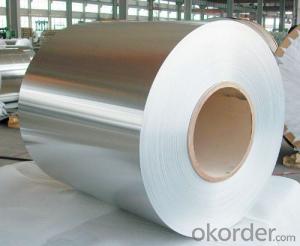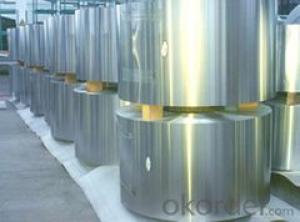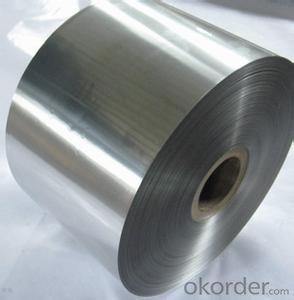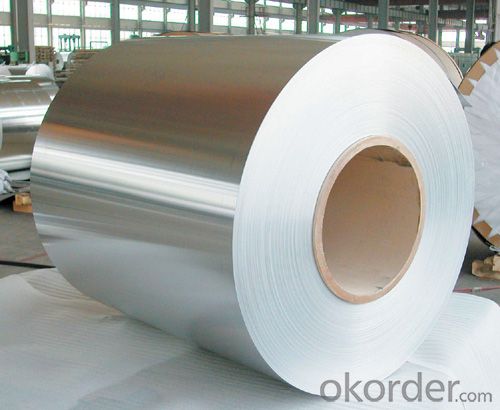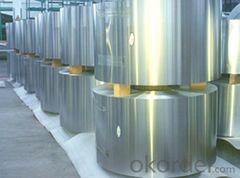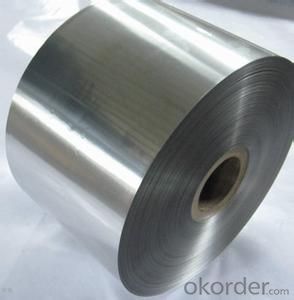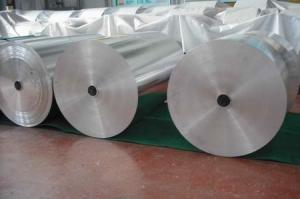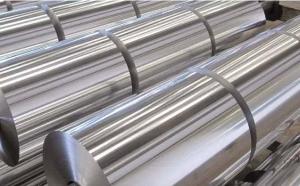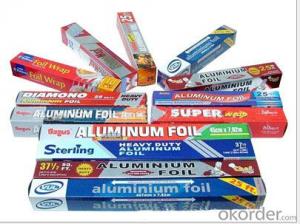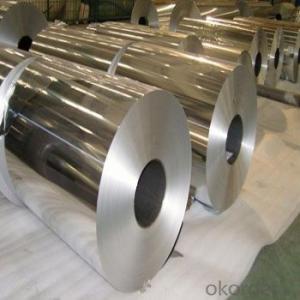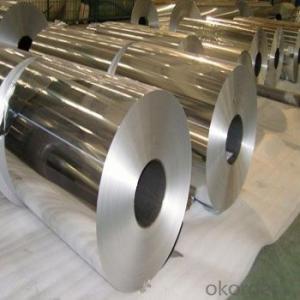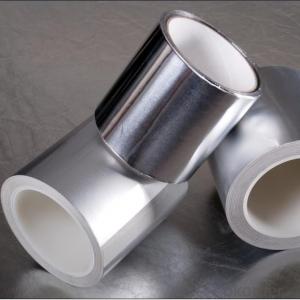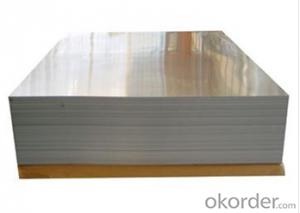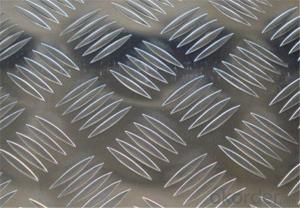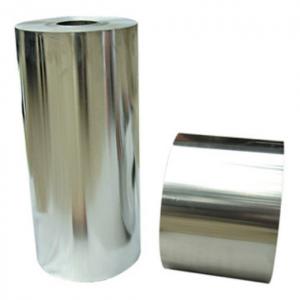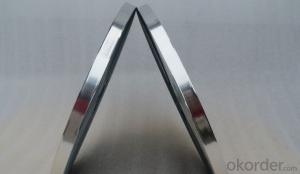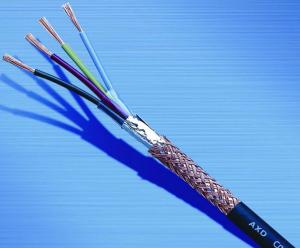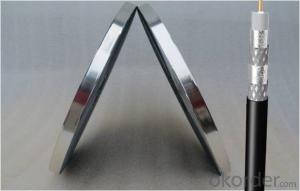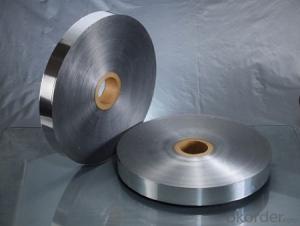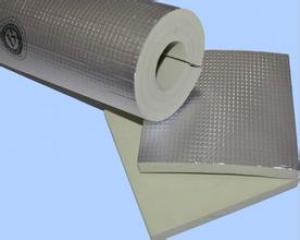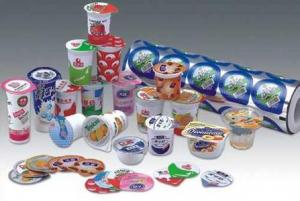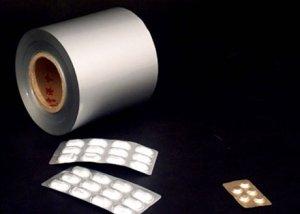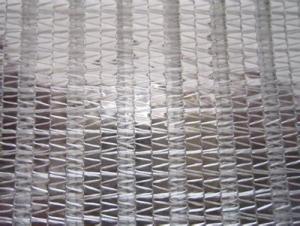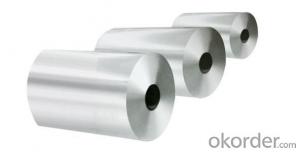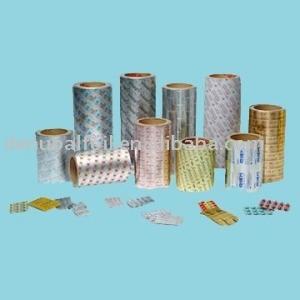Home Depot Aluminum Foil for Cable Wrapping
- Loading Port:
- China Main Port
- Payment Terms:
- TT OR LC
- Min Order Qty:
- -
- Supply Capability:
- -
OKorder Service Pledge
OKorder Financial Service
You Might Also Like
Aluminium foil acts as a total barrier to light and oxygen (which cause fats to oxidise or become rancid), odours and flavours, moistness, and germs, it is used broadly in food and pharmaceutical packaging. The purpose of aluminium is to make long-life packs (aseptic processing|aseptic packaging) for drinks and dairy goods, which allows storing without refrigeration. Aluminium foil containers and trays are used to bake pies and to pack takeaway meals, ready snacks and long life pet foods.
Aluminium foil is widely sold into the consumer market, often in rolls of 500 mm (20 in) width and several metres in length.It is used for wrapping food in order to preserve it, for example, when storing leftover food in a refrigerator (where it serves the additional purpose of preventing odour exchange), when taking sandwiches on a journey, or when selling some kinds of take-away or fast food. Tex-Mex restaurants in the United States, for example, typically provide take-away burritos wrapped in aluminium foil.
Aluminium foils thicker than 25 μm (1 mil) are impermeable to oxygen and water. Foils thinner than this become slightly permeable due to minute pinholes caused by the production process.
Aluminium foil has a shiny side and a matte side. The shiny side is produced when the aluminium is rolled during the final pass. It is difficult to produce rollers with a gap fine enough to cope with the foil gauge, therefore, for the final pass, two sheets are rolled at the same time, doubling the thickness of the gauge at entry to the rollers. When the sheets are later separated, the inside surface is dull, and the outside surface is shiny. This difference in the finish has led to the perception that favouring a side has an effect when cooking. While many believe that the different properties keep heat out when wrapped with the shiny finish facing out, and keep heat in with the shiny finish facing inwards, the actual difference is imperceptible without instrumentation.The reflectivity of bright aluminium foil is 88% while dull embossed foil is about 80%.
We provide a full range of precision aluminum strip for almost any application. We produce aluminum strip in a wide variety of alloys, including clad composites. Our aluminum strip can be produced in standard dimensions or custom made to your special requirements. We produce both imperial and metric units. We manufacture in compliance with the main international specifications, and tighter tolerances or custom tempers are available upon request. We offer various surface conditions, custom finishes (painting, anodizing, embossing), special processing, and multiple packaging options to meet our customer's unique requirements. The following is a summary of our capabilities.
Manufactured in compliance with the main international specifications and standards, including: Aluminum Association, ASTM, EN, and DIN.
We can also manufacture in compliance with other international standards including:ASME, SAE, AMS, AWS, FED, MIL, QQ, ISO, BS, AFNOR, JIS and GOST.
Manufactured in compliance with the main international specifications and standards.
Tighter tolerances are available upon request.
Aluminium (or aluminum; see spelling differences) is a chemical element in the boron group with symbol Al and atomic number 13. It is a silvery white, soft, ductile metal. Aluminium is the third most abundant element (after oxygen and silicon), and the most abundant metal in the Earth's crust. It makes up about 8% by weight of the Earth's solid surface. Aluminium metal is so chemically reactive that native specimens are rare and limited to extreme reducing environments. Instead, it is found combined in over 270 different minerals.The chief ore of aluminium is bauxite.
Aluminium is remarkable for the metal's low density and for its ability to resist corrosion due to the phenomenon of passivation. Structural components made from aluminium and its alloys are vital to the aerospace industry and are important in other areas of transportation and structural materials. The most useful compounds of aluminium, at least on a weight basis, are the oxides and sulfates.
Despite its prevalence in the environment, no known form of life uses aluminium salts metabolically. In keeping with its pervasiveness, aluminium is well tolerated by plants and animals. Owing to their prevalence, potential beneficial (or otherwise) biological roles of aluminium compounds are of continuing interest.
The earliest citation given in the Oxford English Dictionary for any word used as a name for this element is alumium, which British chemist and inventor Humphry Davy employed in 1808 for the metal he was trying to isolate electrolytically from the mineral alumina. The citation is from the journal Philosophical Transactions of the Royal Society of London: "Had I been so fortunate as to have obtained more certain evidences on this subject, and to have procured the metallic substances I was in search of, I should have proposed for them the names of silicium, alumium, zirconium, and glucium."
Davy settled on aluminum by the time he published his 1812 book Chemical Philosophy: "This substance appears to contain a peculiar metal, but as yet Aluminum has not been obtained in a perfectly free state, though alloys of it with other metalline substances have been procured sufficiently distinct to indicate the probable nature of alumina."[69] But the same year, an anonymous contributor to the Quarterly Review, a British political-literary journal, in a review of Davy's book, objected to aluminum and proposed the name aluminium, "for so we shall take the liberty of writing the word, in preference to aluminum, which has a less classical sound."
The -ium suffix conformed to the precedent set in other newly discovered elements of the time: potassium, sodium, magnesium, calcium, and strontium (all of which Davy isolated himself). Nevertheless, -um spellings for elements were not unknown at the time, as for example platinum, known to Europeans since the 16th century, molybdenum, discovered in 1778, and tantalum, discovered in 1802. The -um suffix is consistent with the universal spelling alumina for the oxide (as opposed to aluminia), as lanthana is the oxide of lanthanum, and magnesia, ceria, and thoria are the oxides of magnesium, cerium, and thorium respectively.
The aluminum spelling is used in the Webster's Dictionary of 1828. In his advertising handbill for his new electrolytic method of producing the metal in 1892, Charles Martin Hall used the -um spelling, despite his constant use of the -ium spelling in all the patents[58] he filed between 1886 and 1903. It has consequently been suggested[by whom?] that the spelling reflects an easier-to-pronounce word with one fewer syllable, or that the spelling on the flyer was a mistake.[citation needed] Hall's domination of production of the metal ensured that aluminum became the standard English spelling in North America.
- Q: This has happened to me both with a honey cake and with cornbreadWhen I make quot;wetquot; cakes like apple pie, it bakes perfectlyThe sides bake perfectly, the way the entire cake should be, but for some reason the middle is still very wetI think the problem may be with my oven, not sure, because I have made the cornbread in another oven and it's come out perfectly.So really 2 questions:1) is the problem with my oven?2) How do I fix it? I covered the top with aluminum foil so it doesn't burn, and lowered the pans to the bottom of the ovenAny other suggestions?Thanks in advance!
- whey protein shakes for specifics
- Q: Or is PET film (Mylar?) necessary ?
- NoAluminum foil is too thick to use as a solar filter: no light can get through itThe best solar filters are made by Baader using a specially developed film, significantly better optically than Mylar, called Astro-Solar filmThis is widely available from most astronomy stores, and mounted in excellent aluminum cells from Jim KendrickI have Kendrick filters for all my telescopes.
- Q: I do not like fish, however I am going to put salomon on my barbecue with my chicken.
- Haha, that must be somewhat ironic to try thisi'm actual specific you may recycle plastic, besides the undeniable fact that it relies upon on the place you pass to recycle itRecycling does not consistently recommend melting a steel all the way down to form a different merchandise, it ought to easily be interpreted as re-using some thingSo in case you address this meaning, you need to use a recycling bin different situations.
- Q: .is sterling silver quot;waterproofquot;?? .A sterling ID braclet, can it just be left on all the time, in the shower.etc.or will it turn color.etcIf so, .what material for an ID braclet can be continously worn without getting ruined? Titanium?.thanks
- schedule an appointment with a nutritionist to ensure your diet remains healthy.
- Q: i have a vertical air handler where the indoor fan is below the evap coil, pull through i think it's calledair handler is in a mechanical closet and the primary drain line goes directly to a plumbed in draini don't need a 2nd drain linethere is another stubbed out pvc line coming from the evap that is shooting refrigerated air into the closetis that where a 2nd drain line would go and can i cap it off so that all that extra cold air isnt shooting into the closet? what is that 2nd pvc line for and can i cap it off? thanksjim
- No but look in youtube for other ways of charging batteries There is allot of neat ideas like building a small wind generator from scrap parts such as old speaker magnets copper wire out of transformers things that most people toss in the junk .
- Q: Chemistry Help!! Urgent!?
- 1D.due to revolution of electrons around nucleus,cos partial dipole-dipole bllah blah2.B s of utter action bt - and + molecules.dipole dipole 3.1 c,2 a,3 b,4 d 2(aluminium)-a.Al3+ 3(ion).B.Fe 4.B(chromic.Cr(lll) 3.D(network solids) 4.non polar covalent bond 5.A
- Q: how do i cook beef in oven its a small 1.5lb sirloin roast, how long for what temp
- You'll need: 1 3-5 lb roast 2-3 cloves of garlic 2 sprigs fresh rosemary 2 sprigs fresh thyme 2 tsp kosher salt several cranks of freshly cracked black pepper 3 Tbl olive oil Preheat oven to 350F Put all ingredients except the roast into the bowl of a food processor, and pulse several times until finely choppedYou can also chopped them, and whisk together by handDon't skimp the salt - the salt will work with the natural juices of the roast to form the crusty exterior Rub the garlic/rosemary mixture thoroughly over the surface of the roast, massaging it inInsert the probe of a meat thermometer into the very center of the roast Place in oven, and roast until you reach an internal temperature of 130F for medium rareFor each additional 'step' of doneness, add ten degreesSo medium would be 140, medium well, 150, and well done 160 Pull from the oven when the thermometer reads 130Make a tent of foil and loosely cover the roastYou'll see carryover cooking increase the temperature another 5-10 degreesThat's fine - you planned on it Carve the roast on a cutting board or large platter to catch the juicesDon't waste those - they are delicious too! Use a spoon to drizzle the jus over the meat when you serve it
- Q: If I am sculpting a life size male figure out of an oil based clay like Chavant, what diameter galvanized pipe should I use to support the aluminum wire and the weight of the clay?
- By rigging the load with a stiff loop sticking up and putting a hook down from the copter or vice versa, you could lift a (small, the first answer is right here,) load by maneuvering in to hook the load, lift off, lower the load and back out of the hook to fly offThis is not the way real helicopters do it because they can't safely get that close to the load - so they use a long cable.
- Q: I am going to be going for 4 day camping with about 30 girls and we are going to a campsite right on top of the kern riverI need some good pranks, 2 foil dinner recipes, one with shrimp one without, and some secret sister ideas, thanks!
- running and swimming are excellent ways to lose weight in your stomach area and upper chestcrunches and push-ups tone the muscles of your stomach and upper chest without burning fatanyway the best way would be to do running ,swimming ,crunches and push-ups all togetherP.S: eat healthy food and drink lots of water ( 8 to 12 glasses)
- Q: How many moles of:-AlCl3-Aluminium-Chlorinein .374g of AlCl3I know how to find the moles for AlCl3 however, when it comes to Al and Cl I don't know how to do itCould someone please give me a slightly in-depth response which could help me understand how to find them as well as the answers for them please? Thanks so much!
- a million The balanced equation would be: 4 Al + 3 O2 - 2 Al2O3 because of the fact the ratio of aluminum to aluminum oxide is two:a million, purely multiply the moles of Al2O3 by utilising 2 to get the moles of Al mandatory2 The reaction is between H2 and N2 to furnish NH3H2 + N2 - NH3 To stability it, seeing which you have N2 on the left, you will kind 2 NH3 on the fabulousthat provides you 6 H on the fabulous, so which you would be wanting 3 H2 on the leftThe balanced equation is: 3 H2 + N2 - 2 NH3 So get to the respond, first convert the grams of H2 into moles by utilising dividing the the molar mass of H2Then, use the coefficients of the equation to transform moles of H2 into moles of NH3ultimately, use the molar mass of NH3 to transform moles of NH3 into grams of NH3.
Send your message to us
Home Depot Aluminum Foil for Cable Wrapping
- Loading Port:
- China Main Port
- Payment Terms:
- TT OR LC
- Min Order Qty:
- -
- Supply Capability:
- -
OKorder Service Pledge
OKorder Financial Service
Similar products
Hot products
Hot Searches
Related keywords
